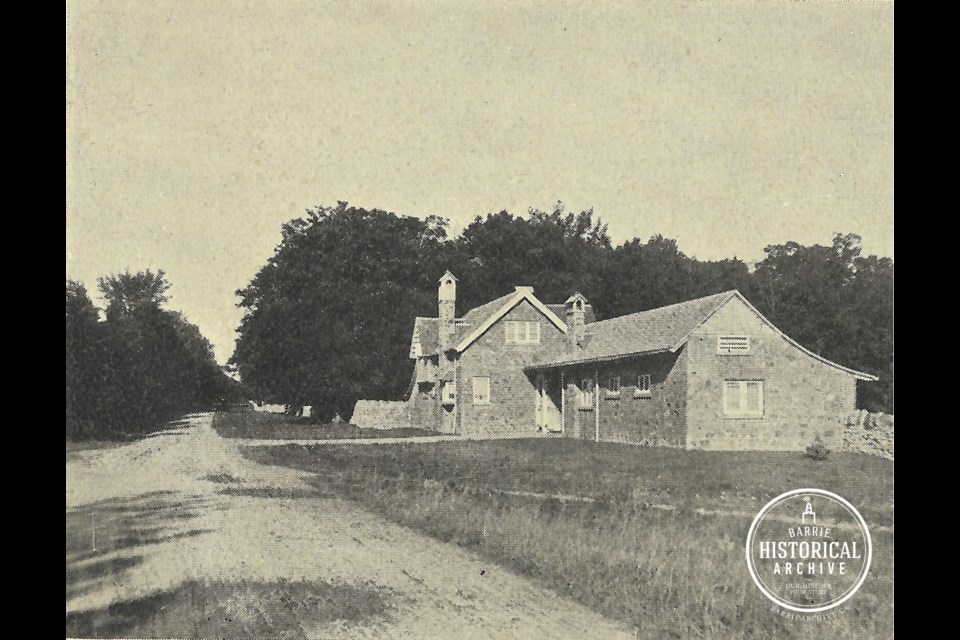This ongoing series from Barrie Historical Archive curator Deb Exel shows old photos from the collection and one from the present day, as well as the story behind them.
Parklands
Head east on Shanty Bay Road and you will find yourself on one of the prettiest routes you can take out of Barrie – Ridge Road.
Just a short drive past Raikes Crossing, where Thunder Bridge would later be built, you'll find a low, jagged rock wall on the lake side of Ridge Road signaled the start of Parklands, the estate of Frederic Nicholls.
Born in London, England in 1856, Nicholls came to Canada in 1874. Over the course of his lifetime he was a businessman, electrical engineer and a Conservative senator from 1917-21.
He is probably best remembered for recognizing electricity as a growth business and seizing the opportunity. He was president of the National Electric Light Association of the United States in 1896-97, bringing their annual convention to Niagara Falls, Ont., during his term.
In 1900, Nicholls became second vice-president and manager of Canadian General Electric. His projects and partnerships in the electricity industry were extensive and important. He worked with Henry Pellet on the opening of the Toronto Power station in 1906, as well as other partners to form the Electric Development Company of Ontario, buying the water rights from the Niagara Parks Commission.
The architect who designed Pellett’s home — Casa Loma — also designed the power generating station in Niagara Falls.
Frederic Nicolls enjoyed sailing and some adventures. His steam launch Minota went aground at Georgina Island in 1902, and his yacht the Temeraire was selected as the challenger for the Canada Cup race in 1905.
But by May 1908, Nicholls had disposed of his Crusader, the Canada Cup contender of 1907, and withdrawn from the vice-commodoreship of the Royal Canadian Yacht Club.
Nicholls wanted to spend more time at his summer home, Parklands, in Shanty Bay.
Parklands was a magnificent property in so many ways. Approximately 85 acres in size, the grounds had everything imaginable for a massive country estate: beautifully maintained lawns, gardens and flowers, natural woodlands, walks, a croquet lawn and bowling green, grass tennis courts and facilities for a nine-hole golf course.
Down at the water, swimmers could enjoy the sandy beach (change rooms conveniently located on the upper floor of the boathouse) as well as the private wharf and breakwaters, complete with a steel and concrete lighthouse, could accommodate both sailing and power boats.
The Nicholls’ summer place was a brick and stone bungalow with attractive mullioned windows and gracious, wide verandas. The house had 17 bedrooms and four bathrooms (Fred and Florence Nicholls had seven children) and on the main floor, spacious dining room, drawing room, billiard lounge and music rooms.
Where it differed from other "cottages," though, was the electricity throughout the house was generated from a private power plant. The home had modern plumbing, waterworks, a sewage system and was fully heated by a furnace. It also had a private railway flag station should you chose to take to train to Parklands instead of driving.
There was also a garage, a stable, a coach house, a 15-room dwelling close to the main house and comfortable quarters for servants.
After eight years, Nicholls put Parklands up for sale in 1911. Within a few months of listing the estate, it became a summer country club for a syndicate of 10 gents, Frederic Nicholls being one of the directors.
Parklands continued to be enjoyed for many years, thanks to the generosity of future owners Mr. and Mrs. J.B. Holden. The highlight of the 1929 Canadian Gladiolus Society’s annual show was a visit to Parklands, the Holdens' summer home, to view the estate and their beautiful gardens.
Mrs. Holden herself had entries in the 1934 Oro Horticultural Society’s annual flower show, taking two Class 'A' prizes for her gladiolas, eight Class 'B' (amateurs only) prizes for verbenas, petunias, gladiolus specimens, nasturtiums, snapdragons and a special prize for the best collection of stocks.
In 1935, the county warden and members of the Oro council, their wives and other officials, along with parliamentary representatives and friends, were invited to tea and to tour the estate as a special outing prior to a township event at the Oro fairgrounds.
Later, in 1951, the Barrie Horticultural and Town Improvement Society visited Parklands to view the outstanding gardens and landscaping, maintained by Mrs. Holden’s gardener, Mr. Robinson.
Although the main house has been demolished, the gardener’s lodge, located alongside Ridge Road, looks almost exactly as it did more than 100 years ago on the splendid Parklands estate.



